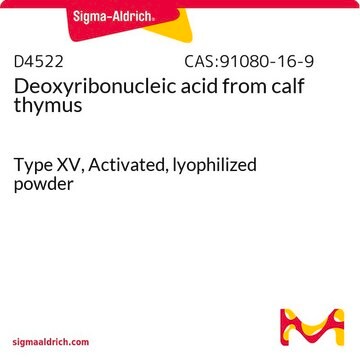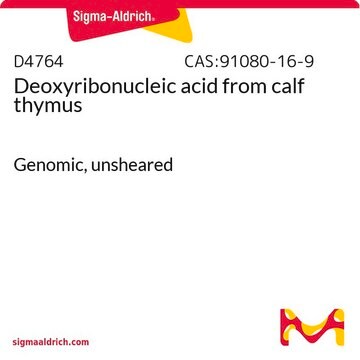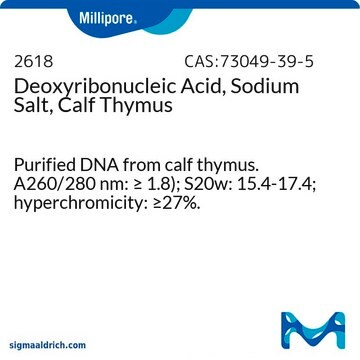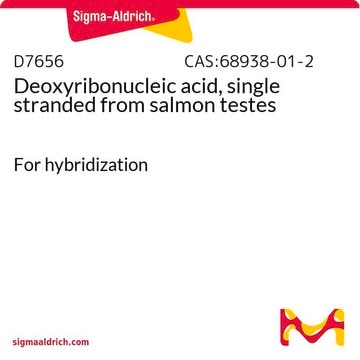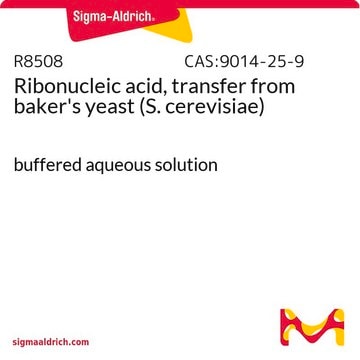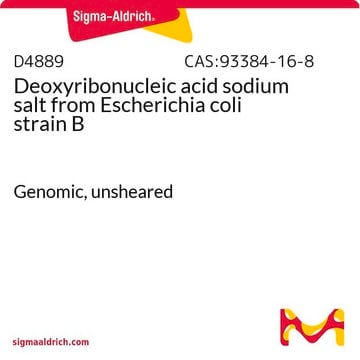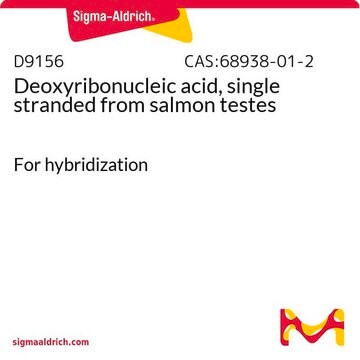D8661
Deoxyribonucleic acid solution from calf thymus
For hybridization
Iniciar sesiónpara Ver la Fijación de precios por contrato y de la organización
About This Item
Productos recomendados
origen biológico
bovine thymus
grado
for molecular biology
Análisis
9-11 mg/mL (DNA concentration)
formulario
solution
Condiciones de envío
dry ice
temp. de almacenamiento
−20°C
Descripción general
A ready-to-use solution of high quality double-stranded template DNA isolated from the thymus of male and female calves. The solution is supplied at a concentration of 9 - 12 mg/ml .
Aplicación
Deoxyribonucleic acid solution from calf thymus is suitable for use as a blocking agent in Southern hybridizations. It was used as negative control in DNA-DNA hybridization experiments using genomic DNA preparations of Vibrio parahaemolyticus and Vibrio alginolyticus. It was used as a standard for DNA quantification by fluorescent assay.
Many factors contribute to the signal-to-noise ratio in nucleic acid hybridizations. These factors include the presence of solvent (formamide), hybridization temperature, length of hybridization, volume of hybridization solution, degree and method of agitation, use of blocking reagents, concentration and specific activity of the probe, use of molecular agents to increase the rate of nucleic acid reassociation, and the degree of stringency used during the washing of the membrane.
In order to decrease any non-specific hybridization of the probe to a substrate, blocking agents must be used. Generally, a combination of blocking reagent, detergent, and denatured, fragmented DNA is used to accomplish this. Sigma offers sonicated, denatured DNA from a variety of species for use as a blocking agent in Northern and Southern blotting and other nucleic acid hybridization techniques.
In order to decrease any non-specific hybridization of the probe to a substrate, blocking agents must be used. Generally, a combination of blocking reagent, detergent, and denatured, fragmented DNA is used to accomplish this. Sigma offers sonicated, denatured DNA from a variety of species for use as a blocking agent in Northern and Southern blotting and other nucleic acid hybridization techniques.
Many factors contribute to the signal-to-noise ratio in nucleic acid hybridizations. These factors include the presence of solvent (formamide), hybridization temperature, length of hybridization, volume of hybridization solution, degree and method of agitation, use of blocking reagents, concentration and specific activity of the probe, use of molecular agents to increase the rate of nucleic acid reassociation, and the degree of stringency used during the washing of the membrane.
In order to decrease any non-specific hybridization of the probe to a substrate, blocking agents must be used. Generally, a combination of blocking reagent, detergent, and denatured, fragmented DNA is used to accomplish this. Sigma offers sonicated, denatured DNA from a variety of species for use as a blocking agent in Northern and Southern blotting and other nucleic acid hybridization techniques.
Deoxyribonucleic acid solution from calf thymus has been used in in situ hybridization and microarray hybridization.
In order to decrease any non-specific hybridization of the probe to a substrate, blocking agents must be used. Generally, a combination of blocking reagent, detergent, and denatured, fragmented DNA is used to accomplish this. Sigma offers sonicated, denatured DNA from a variety of species for use as a blocking agent in Northern and Southern blotting and other nucleic acid hybridization techniques.
Deoxyribonucleic acid solution from calf thymus has been used in in situ hybridization and microarray hybridization.
Nota de preparación
This DNA is phenol-chloroform extracted, ethanol precipitated, and sonicated to produce single-stranded fragments which comigrate with the 587 and 831 base pair marker fragments.
Otras notas
DNA in solution will reanneal on standing at room temperature so it is recommended to boil the solution for 10 minutes and then cool on ice for at least 5 minutes prior to use.
Producto relacionado
Referencia del producto
Descripción
Precios
Código de clase de almacenamiento
12 - Non Combustible Liquids
Clase de riesgo para el agua (WGK)
WGK 2
Punto de inflamabilidad (°F)
Not applicable
Punto de inflamabilidad (°C)
Not applicable
Equipo de protección personal
Eyeshields, Gloves, type N95 (US)
Certificados de análisis (COA)
Busque Certificados de análisis (COA) introduciendo el número de lote del producto. Los números de lote se encuentran en la etiqueta del producto después de las palabras «Lot» o «Batch»
¿Ya tiene este producto?
Encuentre la documentación para los productos que ha comprado recientemente en la Biblioteca de documentos.
Los clientes también vieron
Annick Robert-Pillot et al.
FEMS microbiology letters, 215(1), 1-6 (2002-10-24)
We compared the efficiencies of biochemical methods and polymerase chain reaction (PCR) for the identification of Vibrio parahaemolyticus strains. The 122 isolates studied, identified by biochemical tests as V. parahaemolyticus or Vibrio alginolyticus, were tested by R72H PCR assay. The
C Booth et al.
Nucleic acids research, 29(21), 4414-4422 (2001-11-03)
We have developed a method that allows quantitative amplification of single-stranded DNA (QAOS) in a sample that is primarily double-stranded DNA (dsDNA). Single-stranded DNA (ssDNA) is first captured by annealing a tagging primer at low temperature. Primer extension follows to
William D Hardie et al.
American journal of respiratory cell and molecular biology, 37(3), 309-321 (2007-05-15)
Expression of transforming growth factor alpha (TGF-alpha) in the respiratory epithelium of transgenic mice caused pulmonary fibrosis, cachexia, pulmonary hypertension, and altered lung function. To identify genes and molecular pathways mediating lung remodeling, mRNA microarray analysis was performed at multiple
Lawrence E Heisler et al.
Nucleic acids research, 33(9), 2952-2961 (2005-05-25)
An effective tool for the global analysis of both DNA methylation status and protein-chromatin interactions is a microarray constructed with sequences containing regulatory elements. One type of array suited for this purpose takes advantage of the strong association between CpG
Frequency of aneuploidy in in vitro-matured MII oocytes and corresponding first polar bodies in two dairy cattle (Bos taurus) breeds as determined by dual-color fluorescent in situ hybridization
Nicodemo D, et al.
Theriogenology, 73(4), 523-529 (2010)
Nuestro equipo de científicos tiene experiencia en todas las áreas de investigación: Ciencias de la vida, Ciencia de los materiales, Síntesis química, Cromatografía, Analítica y muchas otras.
Póngase en contacto con el Servicio técnico